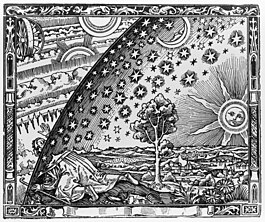Cosmos
Religious and philosophical approaches may include the cosmos among spiritual entities or other matters deemed to exist outside the physical universe.
The verb κοσμεῖν (kosmein) meant generally "to dispose, prepare", but especially "to order and arrange (troops for battle), to set (an army) in array"; also "to establish (a government or regime)", "to adorn, dress" (especially of women).
[5] The 1870 book Dictionary of Greek and Roman Biography and Mythology noted[6] The book The Works of Aristotle (1908, p. 80 Fragments) mentioned[7] Bertrand Russell (1947) noted[8] Anaximander was a pre-Socratic Greek philosopher who is widely referred to as the "father of astronomy" and even as the "father of cosmology" as a result of his works to explain the origin and makeup of the physical universe.
[9] He lived throughout the fifth and fourth centuries, BCE, and was most likely the first philosopher to try to rationalize the system of the Earth, Sun, and Moon by the use of geometry and mathematics.
He postulated that the Earth was at the center of the universe, and that its shape was convex and cylindrical, with life existing on one of the two flat sides.
Next are the fixed stars, which he regarded as wheel-like condensations of air filled with fire, provided at certain places with openings through which flames are discharged.
Finally, on the top of the universe is the Sun, which interacts with the Moon, and the relationship between them is described in terms of aperture, in which a stoppage in would lead to eclipses.
In this model, the Sun is a ring, 28 times the size of the Earth, with a hollow rim, filled with fire, which at a certain place is seen through an aperture as in a pair of bellows.
The explained model, although accredited to Anaximander, did necessarily take from ideas originated in foreign cultures, such as the astronomical wheels which are known from Persian cosmology.
[9] But even without detailed commentary, these elements of the Anaximander tradition give a strong impression of an original and courageous thinker making conscious efforts towards producing a rational explanation of fundamental physical principles, the nature and motion of heavenly bodies, the shape of Earth, its place in the universe, etc.
This was understood to be a crystalline, completely transparent substance that held all of the superlunary spheres in perfect order.
[11] They believed in a stable cosmos created by God, where distinct realms were subject to different kinds of order.
[10] This theory persisted until the Scientific Revolution, when the discovery that the Sun was in the center of the planetary system rocked cosmological understanding to its core.
The most popular of these beliefs was the Xuan Ye theory, the astronomical view of the cosmos as an infinite space with floating pieces of condensed vapor.
[10] This idea was described by Joseph Needham as a cosmos that functioned similarly to a complex organism, with discernible patterns in an ever-changing structure.
The Indian cyclic model assumes the existence of countless island universes, which go through their own periods of development and destruction.
For an early exposition of these astronomical and cosmological ideas, one may read al-Bīrūnī's classic history of Indian science, composed in 1030 AD, and for an even earlier, popular, view of Indian ideas, one may consult the Vedantic text called the Yoga Vāsiṣṭha (YV), which at 32,000 shlokas is one of the longest books in world literature.
[18] Australian cosmology beliefs were based around the Aboriginal and Torres Strait Islander people's ideas, also known as Indigenous astronomy, and it was around before the Babylonians, Greeks, and the Renaissance period.
Multiple indigenous tribes described winter by the Seven Sisters, a group of stars in the sky that provided hunter-gatherers a sort of calendar to indicate whether they should be hunting or gathering, based on the season.
In the Islamic world, Ibn al-Haytham doubted Ptolemy's notion of the planetary orbits, and Muhammad al-Battani recalculated the parameters.
[26] Copernicus began doubting the knowledge of natural philosophers and their beliefs, claiming that geometrical astronomy instead would result in the true reality of the cosmos.
[31][32] Cosmology is the study of the cosmos, and in its broadest sense covers a variety of very different approaches: scientific, religious and philosophical.
According to Charles Peter Mason in Sir William Smith Dictionary of Greek and Roman Biography and Mythology (1870, see book screenshot for full quote), Pythagoreans described the universe.
It appears, in fact, from this, as well as from the extant fragments, that the first book (from Philolaus) of the work contained a general account of the origin and arrangement of the universe.
(p. 305)In September 2023, astrophysicists questioned the overall current view of the universe, in the form of the Standard Model of Cosmology, based on the latest James Webb Space Telescope studies.
The concept of cosmos as the created universe and its arrangement has been important in Christendom since its very inception, as it is heavily used in the New Testament and occurs over 180 times.




